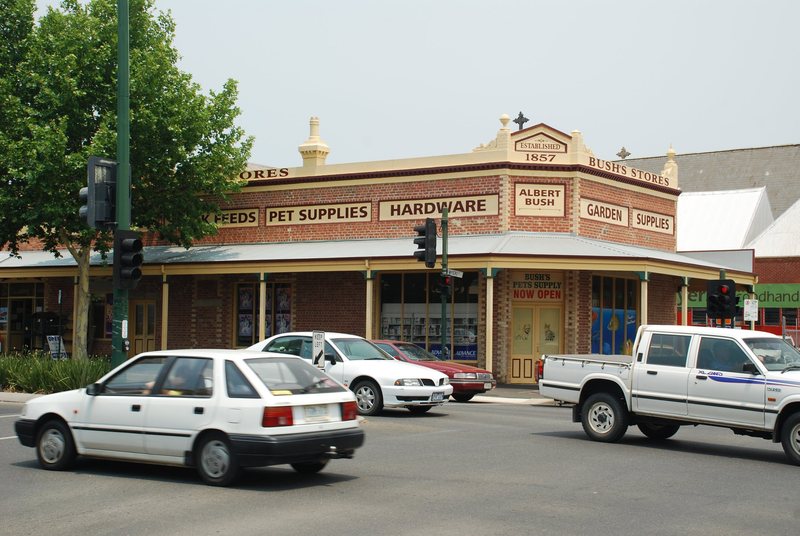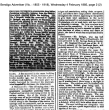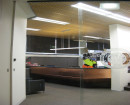FORMER BUSH'S STORE
94 WILLIAMSON STREET AND 12 MYERS STREET BENDIGO, GREATER BENDIGO CITY
-
Add to tour
You must log in to do that.
-
Share
-
Shortlist place
You must log in to do that.
- Download report




Statement of Significance
Bush's Store complex was constructed in stages from 1857 to 1890 during the first generation of settlement at Bendigo. It was built for Albert Bush, one of Bendigo's leading storekeepers in the nineteenth century. Ownership remained in the Bush family and descendants for 140 years until 1997. Much of the original function remains to this day.
The complex comprises a group of Victorian style buildings, mostly designed by John Bain. The corner 1885 building is a single storey brick structure with a brick parapet with cornice and a prominent corner entrance in polychrome brickwork, now painted. The Albert Bush building, built in 1857, is a simple solid brick single storey building with a non original verandah and facade. Some original or early shop fittings remain inside. The two storey double gabled Tea Loft was constructed in 1881 behind the original shop. The original roof was clad in bark and is still in-situ and visible from inside with corrugated iron over. The water well survives between the original 1857 building and Tea Loft building. The 1889-90 two storey bi-chromatic brick Chaff House attached to the rear of the Tea Loft has 'M' shaped king post roof structure lined with weatherboarded 'ceilings'. Most early brick flooring on the ground remains in-situ, upper floors are of timber. The Stable is a two storey, single gabled Victorian polychrome brick building built around 1890. The Oil Store, erected in 1889, is very similar in style, detail and scale to the Stable building. The single storey, skillion roofed, timber framed Shed was relocated from where the Chaff House was erected in 1889-90 to its current location. The building is clad in well weathered weatherboards on the elevation facing Williamson Street and clad with iron elsewhere. The Tea Loft, Chaff House and Stable building retain various original or early equipment.
Bush's Store is of historical and architectural importance to the State of Victoria.
The complex is architecturally important as a rare, large scale generally intact 19th century urban produce processing and commercial complex, constructed in stages from 1857 to 1890, still in use, with few alterations/additions since the 19th century. The complex is notable for the integrity of its interior and remaining equipment. The Tea Loft, Chaff House and Stables retain many traditional fixtures and fittings, machinery and equipment including shop fittings, bag elevator, bag chutes and running gear (pulleys, shafts, chains, timber guides and covers, secured timber ladders, brake pulleys, cathead and associated joinery for the running gear).
The complex is historically important for its association with the Bush family and descendants, a prominent family in Bendigo since the 1850s, who owned and operated the store for 140 years till 1997.
-
-
FORMER BUSH'S STORE - History
Contextual History:History of Place:
Albert Bush was one of Bendigo’s leading storekeepers in the nineteenth century and the complex of buildings which survives (his residence excepted) on the block generally bounded by Myers, Williamson and Mollison Streets and Bush’s Lane reveals evidence of an expanding commercial empire built up in the first generation of settlement at Bendigo.
Albert Bush (1832-1916) was born at Keynsham near Bristol, England. He entered a grocery business where he learnt the trade, eventually becoming proprietor of a business in England. In 1852 he emigrated to Australia, inspired by a talk by J D Lang. He arrived at Brisbane, soon moved to Sydney and then onto the Turong goldfields before preceding to Melbourne then Bendigo, arriving November 1853. After working as a clerk he became a miner. In 1857 he entered into partnership with William Ferris as a grocer, hay and corn merchant, and in 1858 he bought Ferris out. “Trade increased rapidly” and “addition after addition was made to the premises in Williamson Street” according to Cyclopaedia of Victoria (1905). At this time the building (sic) was described as “an immense one, comprising, together with the private residence, an area of over half an acre’. At the rear was a splendidly fitted up, chaff house, where hay is cut into chaff, and corn crushed by means of a powerful engine driven by gas.
Bush retired from active business in 1881 and the firm was carried on by a son. Ownership remained in the Bush family/relatives until 1997. The original function remains to this day, maintaining the link with the nineteenth century.
The complex comprises a group of buildings which are rare survivors of a nineteenth century urban produce processing and commercial complex. The complex is notable for the integrity of interior and some machinery and equipment. At one time Albert Bush lived next door to his original 1857 store, in a two-storey house, since demolished, on the original Lot 7 Section 5C and building may have extended to adjoining Lot 8 Section 5C, (part Lot 7 and all of Lot 8 now Lot 2 on Plan of Subdivision No. 56980.) (The Roman Catholic Trusts Corporation purchased this land in 1963 and which is currently administered by Sandhurst Trustees.)
Mr Albert Bush expanded his business, not only on his own land, but leased land from Henry Backhaus who purchased the prominent Williamson and Myers Streets corner land in 1854. Backhaus erected the buildings on the site for Mr. Albert Bush. This land, as well as the land on which the Caltex Service Station is currently sited, still remains in the Backhaus Estate, held in perpetuality and administered by Sandhurst Trustees.
One of Albert Bush’s employees was George Bain, whose father designed most of Bush’s buildings. In 1885 John Bain designed the store (B1) on the corner of Williamson and Myers Street.
The original shop (B2) fronting Williamson Street dates from 1857. The Tea Loft (B2) was built around 1880. The double gabled Chaff House (B2) was built around 1881. The timber framed shed (B5) on site was apparently relocated to its current location from where the Chaff house was constructed. (This information indicates that this shed at least the second oldest building on the site, and may even predate the 1857 shop building.) The oil store (B4) with full width and length basement was built around 1889. The two storey polychrome brick stable building (B3) was built around 1890. All the literature attributes the expansion of the business to Albert
, and while Albert Bush may have left the business in a sound financial state, most of the expansion was done after his son took over the business in 1881.
COMPARISON:
The buildings with which this building complex can be compared with on the Victorian Heritage Register are,
HBR 568, Carinya (Ladsons Store) (1862-67), Beechworth Road, Tarrawingee.
HBR 777 Tintaldra General Store and former Bakery (1864), Main Street, Tintaldra.
HBR 368 S G deans Grocery and Hardware Store (c.1870), High Street, Yackandandah.
HBR 740 Purcells General Store (1887), 20-22 High Street, Yea
Also Brooks Store, Maldon, currently proposed for the Victorian Heritage Register.
The above buildings are more of the ‘General Store’ variety and of a much smaller scale to Bush’s store. Bush’s store also catered more for farm produce with chaff cutting, grain handling facilities and fodder sales.
Comparisons were also made with flour mills on the Victorian Heritage Register. None can be compared in a meaningful sense. The operation of Bush’s Store business and thus the design requirements of the buildings is/was quite different.
Nothing could be compared with Bush’s Store under the heading Commercial/Industrial in Robert Green’s Index of comparable buildings.
This comparative analysis appears to greatly enhance the significance of the place, it being the only one of its type and scale that survives in Victoria, generally intact, in good condition and with a high degree of integrity with few alterations/additions since the nineteenth century. In addition the original business still continues in B2, B3 and B5.
Associated People: Owner BUSH, A;FORMER BUSH'S STORE - Permit Exemptions
General Exemptions:General exemptions apply to all places and objects included in the Victorian Heritage Register (VHR). General exemptions have been designed to allow everyday activities, maintenance and changes to your property, which don’t harm its cultural heritage significance, to proceed without the need to obtain approvals under the Heritage Act 2017.Places of worship: In some circumstances, you can alter a place of worship to accommodate religious practices without a permit, but you must notify the Executive Director of Heritage Victoria before you start the works or activities at least 20 business days before the works or activities are to commence.Subdivision/consolidation: Permit exemptions exist for some subdivisions and consolidations. If the subdivision or consolidation is in accordance with a planning permit granted under Part 4 of the Planning and Environment Act 1987 and the application for the planning permit was referred to the Executive Director of Heritage Victoria as a determining referral authority, a permit is not required.Specific exemptions may also apply to your registered place or object. If applicable, these are listed below. Specific exemptions are tailored to the conservation and management needs of an individual registered place or object and set out works and activities that are exempt from the requirements of a permit. Specific exemptions prevail if they conflict with general exemptions. Find out more about heritage permit exemptions here.Specific Exemptions:EXEMPTIONS FROM PERMITS:
(Classes of works or activities which may be undertaken without a permit under
Part 4 of the Heritage Act 1995)
Policy
It is the purpose of the permit exemptions to allow continuation of the
operations of the existing businesses, but to preserve original and/or pre
1960's building fabric, machinery and fixtures.
General Conditions:
1. All exempted alterations are to be planned and carried out in a manner
which prevents damage to the fabric of the registered place or object.
2. Should it become apparent during further inspection or the carrying out of
alterations that original or previously hidden or inaccessible details of the
place or object are revealed which relate to the significance of the place or
object, then the exemption covering such alteration shall cease and the
Executive Director shall be notified as soon as possible.
3. If there is a conservation policy and plan approved by the Executive
Director, all works shall be in accordance with it.
4. Nothing in this declaration prevents the Executive Director from amending
or rescinding all or any of the permit exemptions.
5. Nothing in this declaration exempts owners or their agents from the
responsibility to seek relevant planning or building permits from the
responsible authority where applicable.
Exterior
* Minor repairs and maintenance which replace like with like.
* Demolition or removal of (but not replacement or additions to):
* extensions to rear of B-1, on Lot 6, fronting Myers Street
* roof between B-3 and B-4
* Removal of extraneous items such as air conditioners, pipe work, ducting,
wiring, antennae, aerials etc, and making good.
* Installation or repair of damp-proofing by either injection method or
grouted pocket method.
* Repair of chainmesh fences and gates.
* Removal, refurbishment or replacement of the existing silos between B-2 and
adjoining Church property.
* Regular yard maintenance.
* Laying or repair of gravel/toppings to the driveway, but excluding
bitumening, paving or concreting where currently not bitumened, paved or
concreted.
Interior
* Painting of previously painted walls and ceilings provided that preparation
or painting does not remove evidence of the original paint or other decorative
scheme.
* Removal of paint from originally unpainted or oiled joinery, doors,
architraves, skirtings and decorative strapping.
* Installation, removal or replacement of fixed or flexible floor coverings to
B-1 and original shop of B-2.
* Installation, removal or replacement of hooks, nails and other devices for
the hanging of mirrors, paintings, posters and other wall mounted artworks.
* Refurbishment of bathrooms, toilets and or en suites including removal,
installation or replacement of sanitary fixtures and associated piping,
mirrors, wall and floor coverings.
* Refurbishment (including removal, installation or replacement) of post
1960's office fitouts and tea room with associated fixtures, plumbing and
wiring.
* Installation, removal or replacement of electrical wiring provided that all
new wiring is fully concealed and any original/early light switches, pull
cords, push buttons or power outlets are retained in-situ. Note: if wiring
original to the place was carried in timber conduits then the conduits should
remain in-situ.
* Installation, removal or replacement of bulk insulation in the roof space,
except to bark roofed and weatherboarded ceilings of B2.
* Installation, removal or replacement of smoke detectors.
* Removal of non-original false ceilings.
* Installation, removal or replacement of post 1960 machinery and equipment,
provided these works do not damage original or early building fabric and/or
machinery or fixtures.
* Removal of particle board.
-
-
-
-
-
BENDIGO TOWN HALL
 Victorian Heritage Register H0117
Victorian Heritage Register H0117 -
SPECIMEN COTTAGE
 Victorian Heritage Register H1615
Victorian Heritage Register H1615 -
BENDIGO SCHOOL OF MINES (BENDIGO TAFE)
 Victorian Heritage Register H1505
Victorian Heritage Register H1505
-
'Altona' Homestead (Formerly 'Laverton' Homestead) and Logan Reserve
 Hobsons Bay City
Hobsons Bay City
-
-
Images See all images
-

Bendigo Advertiser 1885
Peggy Thurston
-
Public contributions
Images See all images
-

Bendigo Advertiser 1885
Peggy Thurston












